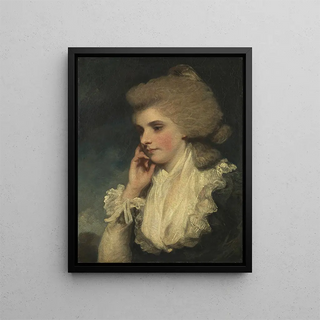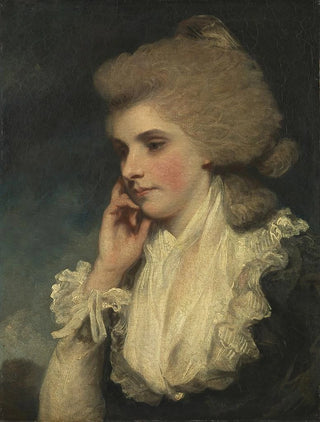Art print | Countess of Lincoln by Frances - Sir Joshua Reynolds


View from behind

Frame (optional)
The painting "French Countess of Lincoln" by Sir Joshua Reynolds is an iconic work that embodies the elegance and sophistication of the 18th century. Created in 1765, this canvas not only illustrates the beauty of its subject but also showcases the technical mastery of the artist, who manages to capture the very essence of British nobility of his time. Gazing upon this masterpiece, the viewer is transported to a world where art and fashion intersect, revealing the subtleties of a society in full transformation. The Countess of Lincoln, dressed in a sumptuous gown, appears almost alive, inviting each observer to ponder her story and her role in high society.
Style and uniqueness of the work
Reynolds' style is distinguished by his refined use of light and shadow, creating depth effects that bring portraits to life. In "French Countess of Lincoln," the chosen color palette is both rich and delicate, highlighting the radiant skin of the countess while emphasizing the luxurious texture of her clothing. The meticulous details, such as the embellishments of the gown and the sparkling jewelry, testify to a concern for realism that characterizes Reynolds' work. Furthermore, the graceful pose and confident posture of the countess convey a certain authority, while maintaining a touch of femininity. This duality reflects the social tensions of the era, where noblewomen were both admired and constrained by strict norms.
The artist and his influence
Sir Joshua Reynolds, a major figure in British portraiture, knew how to leave his mark on his era with an innovative artistic vision. Elevated to the position of royal premier painter, he not only contributed to the evolution of portrait painting but also left an indelible imprint on subsequent generations of artists. His pedagogical approach, based on observation and experimentation, allowed many students to explore new techniques. Reynolds was also a passionate advocate of classical art, drawing inspiration from ancient masters while incorporating contemporary elements. This synthesis of influences allowed

Matte finish

View from behind

Frame (optional)
The painting "French Countess of Lincoln" by Sir Joshua Reynolds is an iconic work that embodies the elegance and sophistication of the 18th century. Created in 1765, this canvas not only illustrates the beauty of its subject but also showcases the technical mastery of the artist, who manages to capture the very essence of British nobility of his time. Gazing upon this masterpiece, the viewer is transported to a world where art and fashion intersect, revealing the subtleties of a society in full transformation. The Countess of Lincoln, dressed in a sumptuous gown, appears almost alive, inviting each observer to ponder her story and her role in high society.
Style and uniqueness of the work
Reynolds' style is distinguished by his refined use of light and shadow, creating depth effects that bring portraits to life. In "French Countess of Lincoln," the chosen color palette is both rich and delicate, highlighting the radiant skin of the countess while emphasizing the luxurious texture of her clothing. The meticulous details, such as the embellishments of the gown and the sparkling jewelry, testify to a concern for realism that characterizes Reynolds' work. Furthermore, the graceful pose and confident posture of the countess convey a certain authority, while maintaining a touch of femininity. This duality reflects the social tensions of the era, where noblewomen were both admired and constrained by strict norms.
The artist and his influence
Sir Joshua Reynolds, a major figure in British portraiture, knew how to leave his mark on his era with an innovative artistic vision. Elevated to the position of royal premier painter, he not only contributed to the evolution of portrait painting but also left an indelible imprint on subsequent generations of artists. His pedagogical approach, based on observation and experimentation, allowed many students to explore new techniques. Reynolds was also a passionate advocate of classical art, drawing inspiration from ancient masters while incorporating contemporary elements. This synthesis of influences allowed






